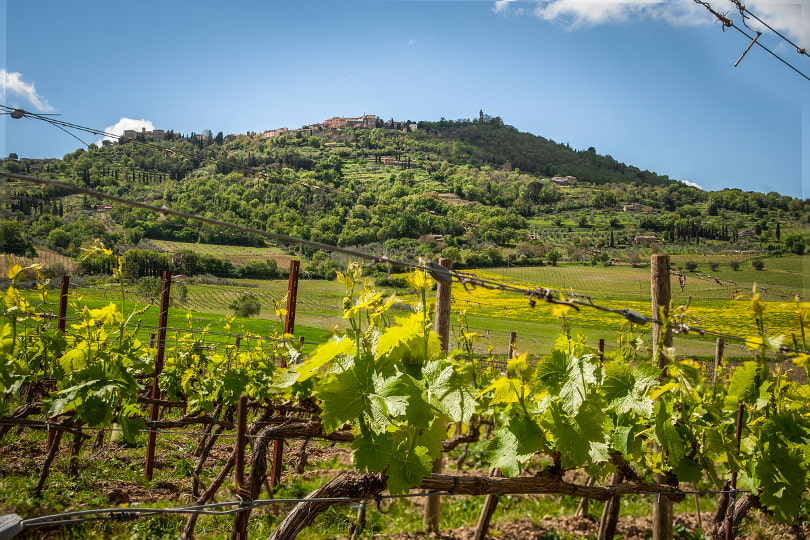
A guide to Brunello di Montalcino vintages

The Montalcino region never loses any sleep over marketing its wines. Its signature red wine export, Brunello di Montalcino, has become much-loved for its rich flavour and astounding depth of personality. Elegant, yet often powerfully structured, the best vintages of Brunello can outlive their owners.
The town of Montalcino, located 40 kilometres south of the city of Siena, is one of Tuscany’s architectural masterpieces. Once an impoverished and obscure Tuscan village, the wider area has morphed into a world-class producer of fine wine. Its undulating landscape is as beautiful as Chianti Classico, with all the prerequisites of cypress trees, olive groves, and endless vines. Awarded UNESCO World Heritage status in 2004, Montalcino is a destination for the Italian connoisseur.
The Montalcino wine zone
Today there are approximately 2600 hectares of vines in Montalcino, cultivated by over 200 winegrowers. The Mediterranean climate, with its typically warm and dry summers, is ideal for late-ripening varieties like Sangiovese.
Official recognition came in 1980, when Brunello was awarded DOCG (Denominazione di Origine Controllata e Garantita) status by the regional authorities. This designation is only given to Italy’s first division wine zones. It requires strict compliance with the rules governing the permitted grape variety, yield and a minimum ageing period. However, the local consorzio (governing body) is not inflexible or resistant to sensible change. Brunello was the first DOCG in Italy to create a ‘junior’ appellation, Rosso di Montalcino. Introduced in 1984, the designation has become extremely popular, due to the attractive price-to-quality ratio. A lighter, fresher interpretation of the style, Rosso may be released at only one, rather than four, years old. Both Brunello and Rosso di Montalcino are legally required to contain 100% Sangiovese.
So what do the wines taste like? A good Brunello di Montalcino wine is no shrinking violet. A textbook example will offer pronounced aromas of sour cherry, raspberry and blackberry in its youth. Balancing relatively high acidity with a dense and concentrated palate, Brunello can sometimes be a little burly in its infancy. But after a decade of bottle age, a mosaic of tertiary aromas and flavours will emerge. Leather, truffle, chocolate and dried fig are the tip of a delicious iceberg. There are reportedly bottles from the 19th century that are still drinkable.
Rosso di Montalcino’s sales pitch is quite different. Approachable from the get-go, the wines are often tangy, fruit-driven and delightfully fresh. Pour a glass and savour the aromas of strawberry, black cherry and plum. Less tannic than Brunello, Rosso di Montalcino seldom disappoints.
The region’s wines are amongst the most reliable in Italy. Producers understand that at these (relatively) high prices, consumers will look elsewhere if standards slide. Montalcino boasts a mass of growers dedicated to supreme quality and a tiny number of indifferent wines.
Montalcino growing seasons
Although the quality of Montalcino’s output is remarkably consistent, there are notable stylistic variances due to terroir (local growing conditions) and the particularities of each vintage. The latter is what maintains a critic’s fascination with wine. Fortunately, no two growing seasons are ever alike and Brunello differs in character but never quality.
Do you prefer the richness and opulence of the 2017 vintage, or the vibrant acidity and lower alcohol of 2014? Do you seek the powerfully structured 2016s, or the accessibility and fruit-driven profile of the 2015s? Although the region enjoys a typically warm-to-hot climate, there are often significant variations each year.
2010, for example, was an exceptional vintage in Montalcino, with a warm growing season which produced complex and elegant wines of immense tannic structure. In 2014, the growing season was atypically cool, with rain in the summer. This yielded beautifully fragrant wines characterised by a crisp acidity. 2015 will be remembered as the vintage of powerful concentration and structure in Montalcino, whereas temperatures soared in 2017, with scant rainfall and a concomitant drought across southern Tuscany.
Brunello is susceptible to distinct variations from vintage to vintage, as most Brunello consumed is the latest vintage meaning there is little opportunity for consumers to try different years.
Stylistic polarity can also result from the distinctive qualities of a particular vineyard. The zone’s topography varies enormously, with important differences in altitude, aspect and soil type. Elevations vary from 150 metres above sea level to the high-altitude vineyards located south of the town of Montalcino itself. Vines planted on soils known as marls (carbonate-rich earth which contains variable amounts of clays and silt) tend to produce the most elegant, perfumed wines. The slopes located directly south of Montalcino enjoy the longest growing season, potentially yielding grapes of vibrant acidity. However, in cooler years, they may struggle to ripen properly.
Ripening grapes is rarely an onerous task in the hot expanse of the Val d’Orcia, situated in the south-west of the zone. The hot micro-climate and relatively low altitudes create powerful, alcoholic expressions of Brunello in the fermenter. Some would argue that the wines further north have more elegance, while others prefer the punchy concentration that the Val d’Orcia so effortlessly provides. However, a growing firmament argues that the finest sites surround the village of Tavernelle. Cooling breezes combine with warm temperatures to create bottled magic.
This is the true beauty of the Montalcino region. It caters to every taste, whim and desire. You start from a point of supreme quality and then narrow it down to individual preferences over vintage, wine producer or style. The best way to demonstrate this is by tasting a series of wines from different vineyards and vintages.




